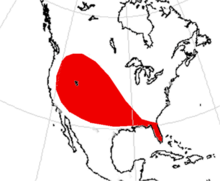Cynarctoides
| Cynarctoides Temporal range: Oligocene–Middle Miocene | |
|---|---|
 | |
| Cynarctoides lemur fossil, University of California Museum of Paleontology. | |
| Scientific classification | |
| Kingdom: | Animalia |
| Phylum: | Chordata |
| Class: | Mammalia |
| Order: | Carnivora |
| Family: | Canidae |
| Subfamily: | †Borophaginae |
| Tribe: | †Phlaocyonini |
| Genus: | Cynarctoides McGrew, 1938 |
| Type species | |
| †Cynarctoides | |
| Species[1] | |
| |
 | |
| Range of Cynarctoides based on fossil record | |
Cynarctoides is an extinct genus of terrestrial canine of the family Borophaginae and tribe Phlaocyonini which inhabited most of North America during the Whitneyan stage of the Early Oligocene to the Barstovian stage of the Middle Miocene 33.3—13.6 Mya existing approximately 19.7 million years.
Origin
Cynarctoides is derived from the Nothocyon and gave rise to Borophaginae, a short-face, heavy-jawed canine usually massive in size. Cynarctoides shared part of its period with a variety of bear dogs like Aelurodontina, Tomarctus and the giant mustelid genus of bone-crushing canidae.
Taxonomy
Cynarctoides was named by P. O. McGrew in 1938 and R. L. Carroll in 1988 and assigned to the family Canidae. Xiaoming Wang later placed it in the Borophaginae genus of Phlaocyonini.
Morphology
Fossil specimens of two individuals' body mass were examined by Legendre and Roth.[2]
- Specimen 1 was estimated at 1.28 kg (2.8 lb).
- Specimen 2 was estimated at 1.21 kg (2.7 lb).
Species
Species within Cynarctoides are:
- Cynarctoides acridens (synonymous with Cynarctus mustelinus) existed for 15 mya †
- Cynarctoides emryi existed for 4.3 mya †
- Cynarctoides gawnae existed for 15 mya †
- Cynarctoides harlowi existed for 4 mya †
- Cynarctoides lemur existed for 11.3 mya †
- Cynarctoides luskensis existed for 4.2 mya †
- Cynarctoides roii existed for 4.5 mya †
Fossil distribution
Sites representing each species of Cynarctoides with age of find:
- Sharps Site, Sharps Formation, Oglala Lakota County, South Dakota, (C. roii) ~30.8—26.3 Ma.
- Buda Mine Site, Alachua County, Florida (C. lemur) ~24.8—20.6 Ma.
- Chugwater Site, Platte County, Wyoming (C. luskensis) ~24.8—20.6 Ma.
- Van Tassel, Niobrara County, Wyoming (C. harlowi) ~24.8—20.6 Ma.
- Split Rock Site, Arikaree Formation, Natrona County, Wyoming, (C. acridens) ~20.6—16.3 Ma.
- Hemingford Quarry 7B, Runningwater Formation, Box Butte County, Nebraska (C. emryi) ~20.6—16.3 Ma.
- Blickomlyus Hill Site, Zia Sand Formation, Sandoval County, New Mexico (C. gawnae) ~20.3—5.3 Ma.
- Hidalgo Bluff Site, Oakville Formation, Washington County, Texas (C. acridens) ~20.3—5.3 Ma.
References
- ↑ Wang, Xiaoming; Richard Tedford; Beryl Taylor (1999-11-17). "Phylogenetic systematics of the Borophaginae" (PDF). Bulletin of the American Museum of Natural History. 243. Archived from the original (PDF) on 2007-03-20. Retrieved 2007-07-08.
- ↑ S. Legendre and C. Roth. 1988. Correlation of carnassial tooth size and body weight in recent carnivores (Mammalia). Historical Biology
- Martin, L.D. 1989. Fossil history of the terrestrial carnivora. Pages 536 - 568 in J.L. Gittleman, editor. Carnivore Behavior, Ecology, and Evolution, Vol. 1. Comstock Publishing Associates: Ithaca.
- Tedford, R.H. 1978. History of dogs and cats: A view from the fossil record. Pages 1 - 10 in Nutrition and Management of Dogs and Cats. Ralston Purina Co.: St. Louis.
- - Bio One Data Base - Cynarctoides